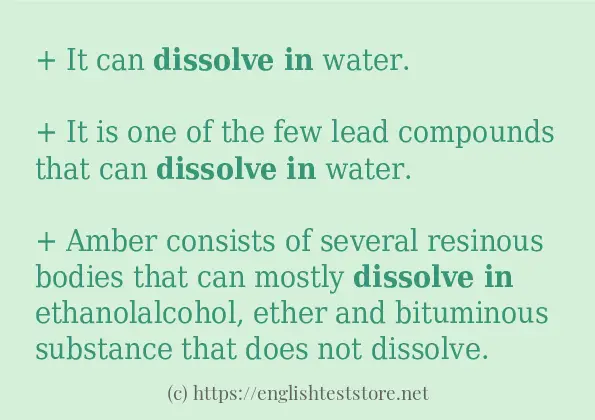How to use in-sentence of “dissolve in”:
+ It can dissolve in water.
+ It is one of the few lead compounds that can dissolve in water.
+ Amber consists of several resinous bodies that can mostly dissolve in ethanolalcohol, ether and bituminous substance that does not dissolve.
+ It does dissolve in dilute nitric acid.
+ Barium carbonate can dissolve in stomach acid, so it is toxic.
+ The lead halides do not dissolve in water.
+ It is the only heavy metal carbonate that can dissolve in water.
+ Gelignite holds the nitroglycerin so that it cannot dissolve in water.

Example sentences of “dissolve in”:
+ Gold does not dissolve in nitric acid.
+ The smaller carboxylic acids dissolve in water.
+ It can dissolve in water very easily.
+ Gold does not dissolve in nitric acid.
+ The smaller carboxylic acids dissolve in water.
+ It can dissolve in water very easily.
+ The B and C vitamins are the vitamins that dissolve in water.
+ Most silver compounds do not dissolve in water.
+ All forms dissolve in acid.
+ It does not dissolve in weak acids.
+ The ones that dissolve in water or stomach acid are very toxic.
+ Plastics from biomass, like some made to dissolve in seawater, are made the same way as petroleum-based plastics, are actually cheaper to manufacture and meet or exceed most performance standards.
+ These compounds are made when bismuth halides dissolve in water.
+ It can dissolve in nitric acid to make copper nitrate and nitrogen dioxide or nitric oxide.
+ It does not dissolve in acids easily.
+ Barium sulfate is well known because it does not dissolve in water or acids.
+ It does not dissolve in acids except nitric acid.
+ It can dissolve in acid.
+ They are colorless solids that dissolve in water easily.
More in-sentence examples of “dissolve in”:
+ It does not dissolve in sulfuric acid.
+ It can dissolve in water to make a bright pink solution.
+ It is miscible in water, which means that it can dissolve in water.
+ It is one of the only sodium compounds that do not dissolve in water.
+ It is toxic, but not as toxic as mercury chloride because it does not dissolve in water.
+ They have a soft texture and easily dissolve in the mouth.
+ The rocks are made of minerals and some of the minerals dissolve in water.
+ Because its oxide does not dissolve in water, it is considered safe for the environment.
+ They are easy to dissolve in water.
+ Most inorganic hydroxide salts do not dissolve in water.
+ Most of them dissolve in water, making them very toxic.
+ It does not dissolve in most acids.
+ They are insoluble in pure water but dissolve in dilute salt solutions.
+ It can only dissolve in acidic solutions.
+ Many mercury compounds do not dissolve in water.
+ It can dissolve in acids and bases.
+ It is a dense, clear, corrosive liquid that can dissolve in water.
+ It can also dissolve in a mixture of hydrogen peroxide and hydrochloric acid.
+ Iodic acid is a white solid that can dissolve in water to make an acidic solution.
+ Both of these minerals do not dissolve in water.
+ Zinc oxide can dissolve in strong bases.
+ It can dissolve in stomach acid.
+ Because hydrogen bonds are what make water stick together so well, they also help other molecules that can make hydrogen bonds dissolve in water.
+ Many phosphates do not dissolve in water.
+ It does not dissolve in potassium hydroxide or concentrated ethanol.
+ Pigments are coloured materials from rocks, plants, that dissolve in water.
+ While it is in the air, CO can dissolve in water droplets to form weak carbonic acid.
+ This makes more gas dissolve in the diver.
+ Arsenic does not dissolve in hydrochloric acid.
+ It is not as toxic as other silver compounds that dissolve in water.
+ The hydrate can dissolve in water.
+ It can dissolve in solutions that have chloride ions in them.
+ It is not toxic in small amounts, but it can dissolve in stomach acid to make soluble copper, which can poison much more easily.
+ A mirage-like effect can be achieved by allowing a soluble substance like sugar or salt to slowly dissolve in a deep container of water, so that there is more sugar in the water near the bottom than in the water above it.
+ Many substances dissolve in water and it is commonly seen as “the universal solvent”; because of this, water in nature and in use is rarely clean, and may have some properties different than those in the laboratory.
+ Iodine does not dissolve in water, but it does dissolve in a solution of an iodide in water.
+ It does not dissolve in water very well.
+ This reaction would produce sulfur trioxide which would dissolve in steam to produce sulfuric acid.
+ Selenium dioxide can dissolve in water to make toxic selenium compounds.
+ Tellurium oxide does not dissolve in water.
+ It does not dissolve in ordinary acids, but can dissolve in oxidizing agentoxidizing acids to make mercury salts.
+ Most other transition metal and post-tranansition metal hydroxides do not dissolve in water.
+ It can dissolve in oxidizing agentoxidizing acids like nitric or sulfuric acid.
+ It does not dissolve in most acids, although it dissolves in concentrated sulfuric acid to make a special red tellurium cation.
+ It does not dissolve in sulfuric acidsulfuric or hydrochloric acid.
+ Items such as plastic pens will dissolve in the solvent bath and may damage textiles beyond recovery.
+ It is dissolved in carbon disulfide because it does not dissolve in water.
+ It does not dissolve in sulfuric acid.
+ It can dissolve in water to make a bright pink solution.
